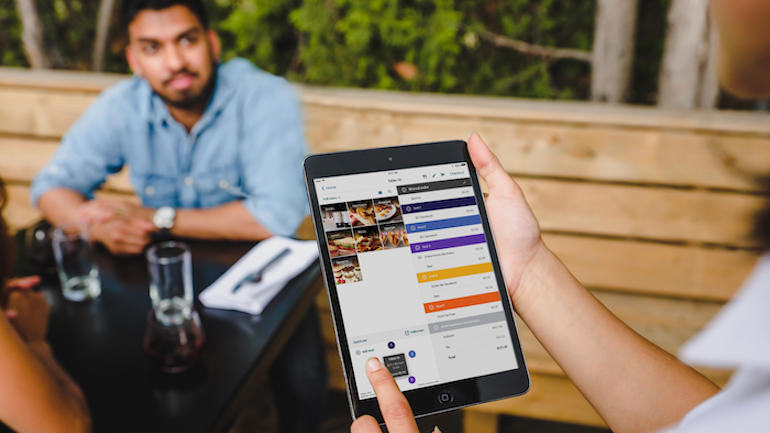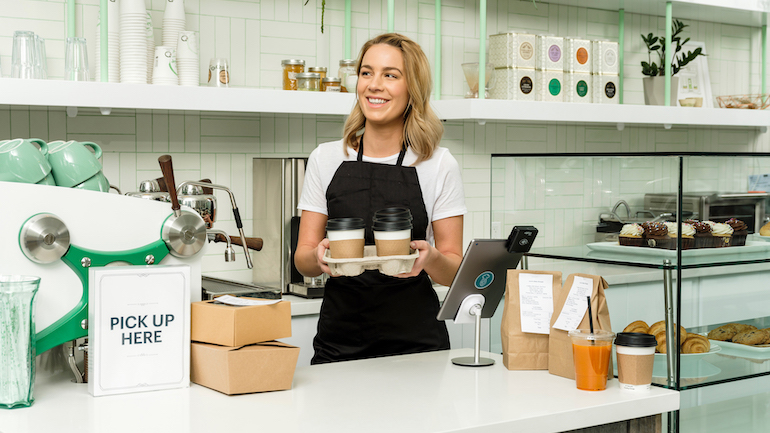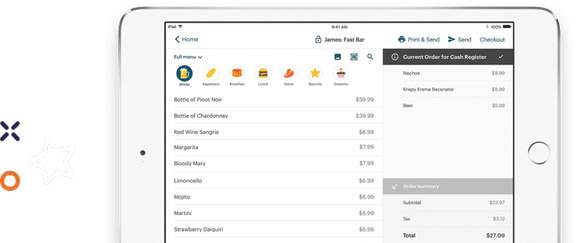Don’t have time to read our TouchBistro vs SkyTab POS reviews? Here are the highlights:
TouchBistro:
– Apple-based hardware and iOS software
– 10+ years of restaurant expertise
– Transparent payment processing rates
– Designed with growth in mind
– Best for small-to-mid-sized QSRs and FSRs
SkyTab:
– Built on Android operating systems and relies on Android hardware
– Built for restaurants, but run by a payment-processing company
– Opaque payment processing rates
– Numerous integration partners
– Best for hotel restaurants
If you’re a restaurant operator looking for a new point of sale (POS) system, chances are you’ve read some TouchBistro and SkyTab POS reviews.
Both TouchBistro and SkyTab are cloud-based POS solutions that are specifically designed to meet the needs of today’s restaurants. However, choosing the best option for your business requires a closer look at the systems’ core features, hardware, payment processing capabilities, add-on software, pricing structures, integration options, and customer support.
In this comprehensive comparison, we’ll review TouchBistro and SkyTab POS systems to help you make an informed decision for your restaurant. We’ll analyze each aspect of these systems side-by-side, so you can see how TouchBistro and TouchBistro competitors, like SkyTab stack up against each other stack in the following categories:
- The foundations of each system
- Core POS features
- Hardware
- Payments
- Other add-on solutions
- Pricing
- Integration partners
- Customer support
Keep reading to discover which POS system aligns best with your restaurant’s unique needs. If you’re exploring options beyond TouchBistro and SkyTab, like SkyTab vs Toast, check out our Ultimate Guide to the Best Restaurant POS Systems.
The information contained on this site is accurate as of the time of publication.
TouchBistro vs SkyTab POS Reviews: An Overview
While both TouchBistro and SkyTab provide restaurant POS software, the systems vary greatly in terms of operating systems, hardware, and regional availability.
Below, we’re providing a detailed look into TouchBistro vs SkyTab POS reviews and analyzing what these differences can mean for your business.
| TouchBistro | SkyTab | |
| POS System | Hybrid cloud-based | Hybrid cloud-based |
| Operating System | iOS | Android |
| Regional Availability | CAD, U.S., and more | U.S. only |
| Hardware (Tablets) | iPads | Proprietary Android hardware |
1. POS System
Both TouchBistro and SkyTab offer cloud-based POS systems with robust offline capabilities. This means you enjoy the convenience of a wireless system that stores all your data on the cloud, while still enjoying the same peace of mind you get from a hardwired connection. In other words, with a cloud-based POS equipped with an offline mode, if your internet connection drops, you can continue business as usual and process card payments, take orders, and more.
However, while they’re both similar systems, TouchBistro’s POS technology has been around since 2011 so it has benefited from a lot of user testing, feedback, and iteration over time. And unlike many other POS providers in the space, TouchBistro has always designed its technology for restaurants, and restaurants only.
The SkyTab POS system, on the other hand, was just launched in 2022, meaning the technology is still in its infancy. In other words, the company lacks the insights and expertise that come from years of operating in the POS sector. Furthermore, SkyTab is owned and operated by Shift4, a payment processor that serves all kinds of industries, which means SkyTab isn’t laser focused on serving restaurants like TouchBistro is.
2. Operating System
A major difference between TouchBistro vs SkyTab is the operating system that each POS runs on.
SkyTab POS uses Android’s mobile operating system. While Android is a highly customizable operating system, it’s generally less secure than other systems, as it’s the main target of viruses and other types of malware. Android systems can also have a steep learning curve for those unfamiliar with the technology.
TouchBistro, on the other hand, runs on Apple’s iOS operating system. The main benefit of an iOS POS is its security. Because Apple’s source code is closed (unlike Android’s, which is open source), hackers can’t examine it and find vulnerabilities to exploit. And while iOS is less customizable than other operating systems, the benefit is that the system is easier for staff to learn how to use, especially if they’re already familiar with Apple products. With 58% of people in North America using iOS and only 42% using Android, chances are your staff members are more familiar with Apple products.
3. Regional Availability
Depending on where your business is based, a POS system’s regional availability can make or break whether you’re able to use it. Here’s how TouchBistro vs SkyTab compare when it comes to global availability.
With parent company Shift4 headquartered in Pennsylvania, SkyTab POS system is currently only available in the United States. According to a chat with SkyTab’s customer support team, the company plans to expand its product to the European Union (though it is unclear when that will happen).
On the other hand, TouchBistro is headquartered in Toronto, Ontario, Canada, and the company has a strong presence across the U.S. and Canada. Outside of North America, TouchBistro is used in more than 100 countries worldwide. This wide availability is not only a benefit for businesses based outside of the U.S., but also for growing businesses that want to expand into new markets.

Core POS Features
Now let’s take a closer look at the POS features TouchBistro and SkyTab have in common and the ones they differ on.
| Core POS Features | TouchBistro | SkyTab |
| Menu Management | ✔ | ✔ |
| Staff Management | ✔ | ✔ |
| Floor Plan Management | ✔ | ✔ |
| Tableside Ordering | ✔ | ✔ |
| Reporting | ✔ | ✔ |
| 1:1 Onboarding | ✔ | ✔ |
| Customer Support | 24/7/365 | 24/7/365 |
When you compare SkyTab vs TouchBistro on core POS features, both platforms are equipped with the following:
- Menu Management: Create and edit menus, menu categories, and menu items.
- Staff Management: Equip employees with different permissions based on their roles.
- Floor Plan Management: Build your restaurant’s floor plan, take orders by table, move parties around, split checks, and more.
- Tableside Ordering: Take accurate orders faster with mobile POS tablets that can be taken tableside.
- Reporting: See how your business is performing in real time or at the end of the day.
At a glance, these two systems have similar core POS features because they’re both built for restaurants. However, reviews from SkyTab customers highlight frequent glitches in the system’s core features, such as difficulty editing menu items and modifiers, recording tips, and accessing reporting.
TouchBistro’s core POS features are reliable, easy-to-use, and designed to help you grow your business, whether you have one location or multiple. In fact, TouchBistro is equipped with multi-location POS features, like bulk menu editing capabilities, that simplify running several locations.
Hardware
Examining the differences in POS hardware TouchBistro and SkyTab have can help you decide which system is the best fit for your restaurant. Here is an overview of the POS hardware options for each system:
SkyTab POS System Android Tablets
SkyTab POS system has multiple hardware options that run on Android software, ranging from tabletop POS tablets to portable devices. This means there’s hardware available for every kind of need, in every kind of restaurant – from poolside bars to full service venues. While this means operators have a lot of options, these options come at a steep price. Because SkyTab uses proprietary Android tablets, you’ll need to invest a lot of money upfront for a full hardware setup.
SkyTab POS reviews note that not only can this proprietary Android hardware be expensive and difficult to source, but it also comes with a steeper learning curve, especially if your employees are more familiar with Apple products.
TouchBistro iPads
TouchBistro takes a simpler approach to hardware, as the system revolves around one key solution: an iPad. TouchBistro’s non-proprietary hardware setup is powered by reliable Apple iPads and other leading hardware that’s easy to set up and a cinch to source and replace, if needed. You can even bring your own hardware to TouchBistro if you own some newer iPad models.
The familiarity of Apple’s interface also means that your staff will have less of a learning curve than if your restaurant used different hardware.
Add-On Solutions
While TouchBistro and SkyTab have similar core POS features, they’re a little easier to distinguish by the add-on solutions they provide.
Payments
One of the most essential add-on solutions for any restaurant is a payment processing solution. While some restaurants use unintegrated payment processors, many are choosing systems that integrate with their POS for better performance and streamlined admin. Here’s how TouchBistro and SkyTab compare:
| Payments | TouchBistro | SkyTab |
| Payments Pricing Model | Cost plus (interchange plus) pricing | Cost plus (interchange plus) pricing |
| Payment Processing Fees | TouchBistro Payments (U.S. only): Interchange + processing fee Integrated Payments for Online Ordering: 2.9% + $0.30 / transaction (CAD) Competitive card-not-present processing fees (U.S.) | Not available |
Since payment processors charge fees in exchange for their services, the fee structure your POS provider offers use can make a world of difference in your bottom line. Both TouchBistro and SkyTab’s payment processing solutions rely on cost-plus pricing, which charges an interchange fee set by the card network (Visa, Mastercard, etc.), and a markup set by the payment processor.
The markup is where things get tricky. TouchBistro makes its rates transparent and competitive. SkyTab, on the other hand, obscures its rates. The company’s website says it builds “a customized rate for you based on your business, volume, and average ticket size,” but doesn’t share information on what that rate might be.
Because SkyTab POS is owned by payment processor Shift4, its main goal is generating revenue for Shift4. According to SkyTab’s contract, it can raise its payment processing fees at any time, with 30 days’ notice. Plus, if restaurateurs try to use a payment processor other than Shift4 with their SkyTab POS, they’re charged hundreds of dollars each month in non-processing fees. In short, everything from SkyTab’s pricing model to its terms of service has been designed to serve the primary goal of growing the company’s payment processing revenue, and not helping small businesses grow.
TouchBistro’s payment terms, on the other hand, are transparent and its rates are competitive. TouchBistro isn’t owned by a payment processor, but rather partners with trusted payment processors so it can keep the focus on building best-in-class technology for restaurants. For TouchBistro, payments processing is only part of its POS system and its primary goal is to empower customers.

Other Add-On Solutions
From online ordering and reservations to gift cards and marketing, both TouchBistro and SkyTab POS systems offer solutions like these as additions to their core capabilities.
| Add-On Solutions | TouchBistro | SkyTab |
| Integrated Payments | ✔ | ✔ |
| Online Ordering | ✔ | ✔ |
| Integrated Delivery | ✔ | ✔ |
| Reservations | ✔ | ✔ |
| Gift Cards | ✔ | ✔ |
| Loyalty and Customer Relationship Management | ✔ | ✔ |
| Marketing | ✔ | ✔ |
| Inventory & Back Office Management | ✔ | ✘ |
| Self-Serve Kiosks | ✘ | ✘ |
| Kitchen Display System | ✔ | ✔ |
| Customer Facing Display | ✔ | ✔ |
| Digital Menu Board | ✘ | ✘ |
At a glance, both SkyTab POS reviews and reviews of TouchBistro POS reveal many similarities when it comes to add-on solutions, including:
- Payments: Integrated payment processing.
- Online Ordering: Customers place orders directly through a restaurant’s website and those orders are sent to the POS in real-time.
- Delivery: Restaurants can use in-house or third-party delivery drivers to fulfill online orders.
- Reservations: Customers can make reservations online, while restaurants can manage bookings, track table status, and the waitlist.
- Gift Cards: Branded physical and digital gift cards.
- Loyalty and CRM: A CRM and rewards program that helps keep customers coming back for more.
- Marketing: A tool that helps restaurateurs create and automate marketing campaigns.
- Kitchen Display System (KDS): A digital ticketing system that keeps the kitchen organized.
- Customer Facing Display: A display system that lets customers see and confirm their orders.
While SkyTab’s range of add-on solutions is impressive, one important solution that’s missing is a back-office tool that can help you handle invoices, orders, profits, and more.
TouchBistro, on the other hand, is built to handle your business from the front of the house, to the back of the house, to guest engagement. For instance, TouchBistro Profit Management, TouchBistro’s comprehensive back office solution, helps busy restaurateurs order inventory from one platform, automate inventory management, track profitability in real time, and much more.
Integration Partners
When POS providers don’t have in-house tools for certain functionalities, they integrate with third-party systems to satisfy their business needs. Here’s how TouchBistro and SkyTab compare when it comes to integration partners.
| Integration Partners | TouchBistro | SkyTab |
| Online Ordering and Delivery | ✔ | ✔ |
| Reservations | ✘ (in-house solution) | ✘ (in-house solution) |
| Loyalty | ✘ (in-house solution) | ✘ (in-house solution) |
| Staff Management, HR, and Payroll | ✔ | ✔ |
| Inventory Management | ✔ | ✔ |
| Accounting | ✔ | ✔ |
| Reporting and Analytics | ✔ | ✘ (in-house solution) |
Both TouchBistro and SkyTab integrate with the following types of third-party partners to extend the capabilities of their POS systems:
- Online Ordering and Delivery Marketplaces: Leverage delivery driver fleets through solutions like DoorDash Drive, while online ordering aggregators help you take manage orders coming from multiple third-party delivery apps.
- Staff Management, HR, and Payroll: Tools like 7shifts that help you manage, schedule, and pay your employees.
- Inventory Management: Take advantage of inventory solutions designed specifically for restaurants, like MarketMan.
- Accounting: Cloud accounting tools and middleware software like QuickBooks and Shogo make accounting and bookkeeping a breeze.
When you’re comparing TouchBistro and SkyTab POS reviews on the basis of integrations, both systems partner with many of the same solutions. However, SkyTab stands out for its property management integrations, which are a major asset to hotel restaurants. Integrations with eZee, Opera 5, and Opera Cloud help restaurants fit seamlessly into a hotel’s ecosystem and streamline data sharing, communication, reservations, and more.
For standalone restaurants, TouchBistro’s very curated list of best-in-class partners may be smaller, but it perfectly complements an already extensive all-in-one system. While having an extensive list of integrations to choose can be great, it’s generally easier to manage your system and day-to-day operations when all of your features are already built into your POS. Having everything on one system means you don’t have to worry about the flow of data from a partner platform into your POS, or troubleshooting if the integrations don’t work as intended.

TouchBistro vs SkyTab POS Pricing
One of the biggest considerations when shopping for a POS system is price. And when you look at how TouchBistro and SkyTab POS reviews compare in terms of cost, it’s important to read the fine print.
| Pricing | TouchBistro POS Pricing | SkyTab POS Pricing |
| Software Pricing | Starting at $69 USD / month for a single license | Starter Bundle: $29.99/moTable Service Bundle: $49.99/moCounter Service Bundle: $59.98/mo |
While SkyTab POS pricing starts low, restaurants quickly make up these savings by paying high payment fees. SkyTab can increase its payment processing rates at any time, with just 30 days’ notice. And if you switch to an external payment processor, you’ll be penalized hundreds of dollars each month.
In contrast, TouchBistro’s software pricing and its payment processing rates are competitive, transparent, and don’t come with hidden fees. Plus, TouchBistro’s software is compatible with the majority of iPad models, so you can bring your own hardware, or source it elsewhere, which can save you money.
Customer Support
When comparing TouchBistro vs SkyTab POS reviews in terms of customer support, the competition is stiff. Both POS companies have 24/7/365 technical support and customer service.
Because its proprietary software and hardware will be unfamiliar to most customers, SkyTab provides onsite installation. TouchBistro has do-it-yourself installation of its intuitive hardware and software and offers plenty of resources along the way. But while SkyTab advertises accessible support, its worth noting that some customers have complained that it’s difficult to actually get help when you need it.
If you need to call for help, most of TouchBistro’s support team is made up of current and former restaurant staff, so they’ll have first-hand experience with any issue you’re facing. Plus, TouchBistro’s support is available 24/7, 365 days of the year, so you can get support anytime (not just during 9-5).
Both POS systems also have rich libraries of documentation to help you quickly find the solution to any issue if you don’t feel like picking up the phone.
TouchBistro vs SkyTab POS Reviews: The Bottom Line
If you’ve gotten this far in our TouchBistro vs SkyTab POS review comparison, you’ve probably noticed that both POS systems are equipped to tackle most needs that food service businesses have. Both options are designed just for restaurants and boast comprehensive core features and add-ons.
However, when you look at the differences in the systems, that’s where it’s easier to discern which POS is a better fit for your business. With no back-office solution for restaurants, multiple property management integrations, payment terms that favor high volumes, and several mobile hardware options, SkyTab is clearly the right choice for hotel restaurants.
When it comes to standalone small-to-mid-sized FSRs and QSRs, however, TouchBistro is the best restaurant POS for three main reasons:
1. Growth Potential
SkyTab is exclusively available to restaurateurs in the United States. TouchBistro, on the other hand, has a prominent footprint in North America and has customers all over the world. So whether you’re opening a second restaurant across the city or across the world, TouchBistro is built with your business’ growth in mind.
Indeed, TouchBistro multi-unit management capabilities are designed to help you scale quickly and easily. For instance, withTouchBistro you can manage multiple menus from one dashboard, saving you countless hours. Centralized reports also let you see sales and other important figures from one place, so you can easily make decisions that move your business forward. And, with seamless operational control, you can easily manage staff from all locations from one place. All of these capabilities save you time and help you do more with less, so you can focus on growth and seamlessly replicate your processes across multiple locations.
2. iOS Operating System and Apple Hardware
The restaurant industry is fast paced. During training, your staff members need to be able to get up to speed on your POS system in a matter of hours, not days. And, during service, they need to know how to use the system flawlessly to avoid slowing down service, upsetting customers, and losing sales.
While the kind of Android software and proprietary Android hardware that SkyTab relies on, have their advantages, Apple and iOS are widely considered the more reliable and user-friendly option for restaurant POS systems. TouchBistro’s hardware and software is built on Apple systems, which many of your team members already have experience with, whether from using their personal mobile devices or iPads at other restaurants.
Another advantage of TouchBistro running on iPads is that you can bring your own hardware, instead of having to purchase an entirely new setup, like you do with SkyTab POS.
3. Transparent Pricing
With the restaurant industry running on thin profit margins, operators need to be able to predict their costs to maximize profits. TouchBistro’s straightforward, transparent pricing for software, hardware, and payment processing makes it easier to know how much you’ll be spending each month on key expenses. Because TouchBistro is built by restaurateurs for restaurateurs, the company’s sole focus is on helping customers grow.
SkyTab, on the other hand, is owned by a payment processor that obscures its fees and raises rates unpredictably. If you choose to go elsewhere for payment processing, you’ll be penalized with steep fees. From unfair payment processing fees to expensive proprietary hardware, it’s hard to know how much SkyTab POS pricing will actually cost you and to budget accordingly.
For predictable costs, user-friendly systems, and growth potential, TouchBistro POS is the obvious choice for small-to-mid sized restaurants. If you want to keep doing your research and are looking for insights on TouchBistro vs SkyTab vs Toast, check out our review comparing TouchBistro to Toast.






